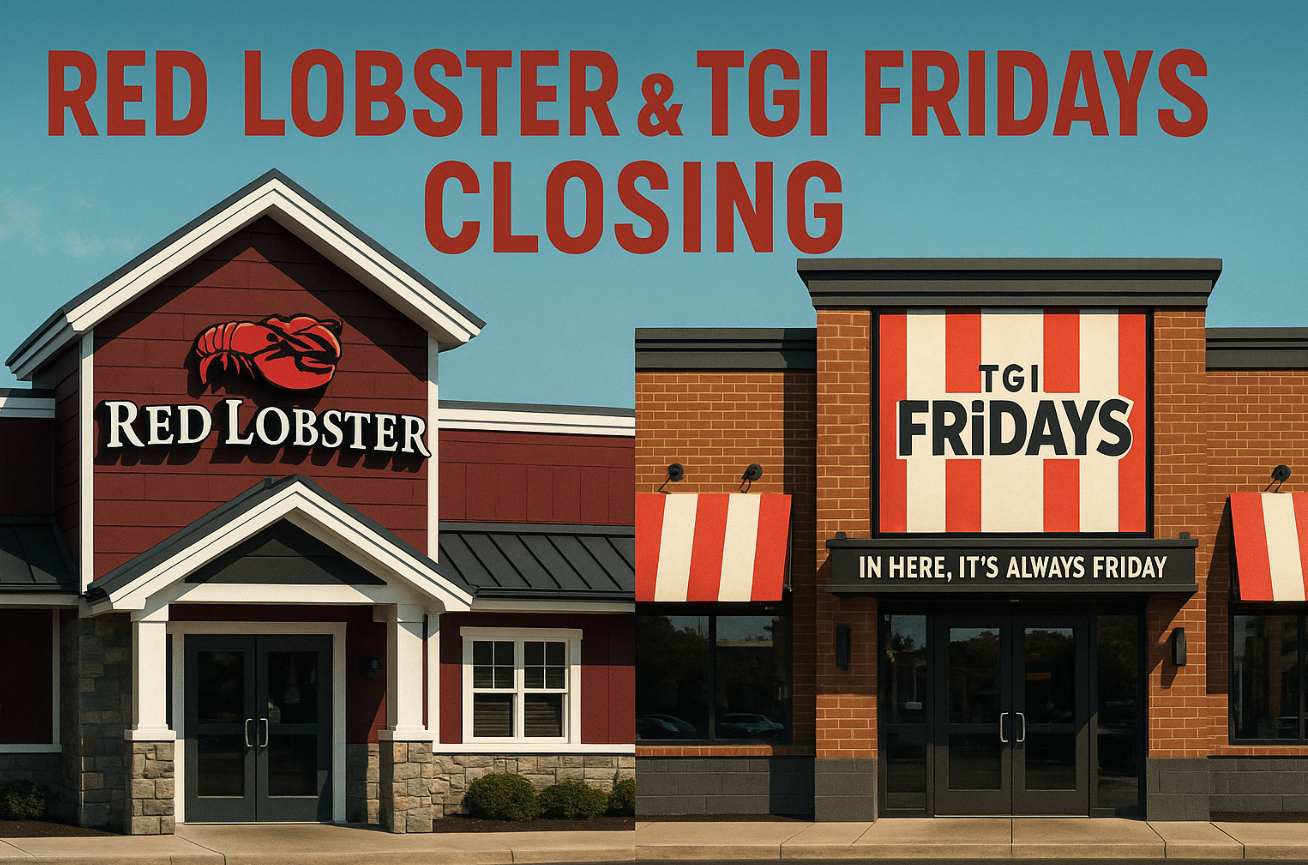The news has hit hard: Red Lobster and TGI Fridays are closing their doors. These iconic American chains have been staples in the dining scene for decades, serving up everything from buttery shrimp scampi to endless baskets of cheesy breadsticks. But as we navigate a post-pandemic world, even these beloved establishments can’t escape the shifting tides of consumer habits and preferences.
With the impact of COVID-19 still resonating throughout the restaurant industry, many are left wondering what led us to this point. Is it merely a result of changing tastes or something more profound? Join us as we explore how these closures mark not just an end but also a transformation in casual dining culture. From employee experiences to new alternatives on the horizon, let’s dive into what this means for diners and communities alike.
The End of an Era: Red Lobster and TGI Fridays Closing Their Doors
The closure of Red Lobster and TGI Fridays not only signifies a significant shift in the landscape of casual dining but also evokes a sense of nostalgia. For many, these restaurants have been go-to spots for celebrations, family gatherings, and late-night cravings. Their absence will leave a nostalgic void that echoes through communities across the country.
As familiar chains fade away, it raises questions about what diners truly seek today. The allure of endless shrimp or signature cocktails may not hold the same charm as before. With evolving tastes and preferences, customers are leaning more toward unique experiences over traditional fare.
This moment also serves as a wake-up call for other establishments within this sector. Adapting to consumer demands is no longer optional; it’s essential for survival in an increasingly competitive market where innovation reigns supreme. This necessity for change brings hope for a vibrant and diverse future of dining.
Impact of COVID-19 on the restaurant industry
The COVID-19 pandemic drastically altered the landscape of the restaurant industry. Lockdowns and social distancing measures forced many establishments to close their doors, leading to unprecedented financial strain. Even iconic names struggled under these new conditions.
As dining preferences shifted suddenly, many customers turned to takeout and delivery options. This change put immense pressure on traditional dining experiences as restaurants scrambled to adapt. The reliance on technology surged, with online ordering becoming a lifeline for survival.
Some chains weathered the storm better than others, but overall, uncertainty lingered in every corner of the sector. With restrictions easing now, it’s clear that recovery will be slow and complex for many beloved brands like Red Lobster and TGI Fridays.
Decline in popularity of chain restaurants
Chain restaurants once dominated the dining landscape, offering familiar menus and a predictable experience. However, over recent years, their appeal has waned. Consumers are now seeking unique culinary experiences that reflect local flavors and innovative concepts.
The rise of food trucks, farm-to-table eateries, and independent cafes has reshaped preferences. Diners crave authenticity and personalization in their meals. They want to explore new tastes rather than stick with the same old chains.
Social media also plays a role in this shift. Platforms like Instagram highlight visually stunning dishes from small restaurants instead of standard fare found at chain locations. The allure of “Instagrammable” plates is pushing diners toward more creative options beyond traditional franchises.
Changing consumer preferences in dining
Consumer preferences in dining have shifted dramatically over recent years. People are now prioritizing freshness and local ingredients, which has led to a rise in farm-to-table restaurants. Diners seek authentic experiences rather than the standardized offerings found at chain establishments.
Health-conscious choices also play a significant role. Many consumers are more aware of nutritional values and food sourcing. This awareness drives them toward options that align with their lifestyles, such as vegetarian or vegan dishes.
Moreover, convenience is king in today’s fast-paced world. Takeout and delivery services have skyrocketed, prompting diners to bypass traditional sit-down meals for quick and satisfying alternatives. As tastes evolve, it’s clear that restaurant chains like Red Lobster and TGI Fridays face challenges adapting to this new landscape.
Future of Casual Dining Chains
The future of casual dining chains is uncertain but intriguing. As consumer preferences evolve, brands must adapt or risk fading into obscurity. Many establishments are exploring innovative menus and enhanced dining experiences to attract guests. This could involve a shift towards healthier options, more diverse menus, or unique dining experiences that cannot be replicated at home.
Technology will play a significant role moving forward. Digital ordering, contactless payments, and online reservations can streamline operations and elevate customer satisfaction. Embracing these tools may help chains like Red Lobster and TGI Fridays regain relevance in an increasingly competitive landscape, sparking intrigue and anticipation for the future of dining.
Health-conscious consumers are also reshaping the industry. Diners now seek fresh ingredients and diverse options that cater to various dietary needs. Casual dining chains might need to rethink their offerings if they want to capture this growing segment of health-focused patrons seeking unique culinary experiences.
Alternative options for consumers
As Red Lobster and TGI Fridays close their doors, consumers are exploring new dining options. Local eateries and food trucks have surged in popularity. These establishments often offer unique flavors that chain restaurants can’t replicate.
Many people now favor meal kits or subscription services that bring fresh ingredients to their doorsteps. This option allows for culinary creativity at home while saving time and money.
Additionally, the rise of delivery apps has transformed how we eat out. Diners can enjoy a wide range of cuisines from various local restaurants without leaving their homes. It’s an exciting time for food lovers seeking something different in the evolving dining landscape.
Employee Impact and Community Response
The closure of Red Lobster and TGI Fridays has left many employees facing uncertainty. Thousands have lost their jobs or seen reduced hours, creating economic strain for families who relied on these positions. The sudden shift in employment has hit hard across communities that once thrived with bustling restaurants. This is not just a loss of dining options but a significant blow to the local economy and the livelihoods of many.
Local responses have emerged as a beacon of hope. Many community members are rallying to support former employees through fundraisers and job fairs, showing solidarity during this challenging time. Local businesses are stepping up, too, offering opportunities to those affected by the closures.
Social media platforms buzz with stories shared by loyal patrons expressing gratitude for the years spent at these beloved chains. This outpouring reflects not just a loss but also a sense of connection that spans beyond mere dining experiences.
Red Lobster and TGI Fridays Strategies
Red Lobster and TGI Fridays have long relied on their signature dishes to attract customers. Red Lobster’s famous Endless Shrimp promotion has been a staple, drawing seafood lovers in droves. Similarly, TGI Fridays has focused on its vibrant atmosphere and indulgent appetizers like loaded potato skins to create a loyal following.
Both chains have also embraced digital transformation. Online ordering and delivery services became essential during the pandemic. They invested in user-friendly apps that let customers enjoy their favorites from home.
To adapt further, they’ve turned to limited-time offers and seasonal menus. These strategies aim to entice diners back while keeping offerings fresh and exciting. The goal is clear: rekindle interest among patrons who may have drifted away over time.
Conclusion: Reflecting on the end of an era for Red Lobster and TGI Fridays
The closing of Red Lobster and TGI Fridays marks the end of an era for many. Once icons in the casual dining scene, these restaurants represented a unique blend of comfort food and social gathering spots. As we reflect on their legacy, it’s clear they shaped countless memories for families and friends.
The impact goes beyond just lost jobs or shuttered doors; it’s about shifting cultural norms around dining experiences. Casual dining was once synonymous with celebration and togetherness, but changing consumer preferences have altered that landscape dramatically.
As diners seek new culinary adventures or healthier options, establishments like Red Lobster and TGI Fridays must adapt to survive. Their stories remind us that every ending is also a beginning—a shift toward what may come next in our ever-evolving food culture. The nostalgia remains strong as we navigate this transition into the future of dining.

